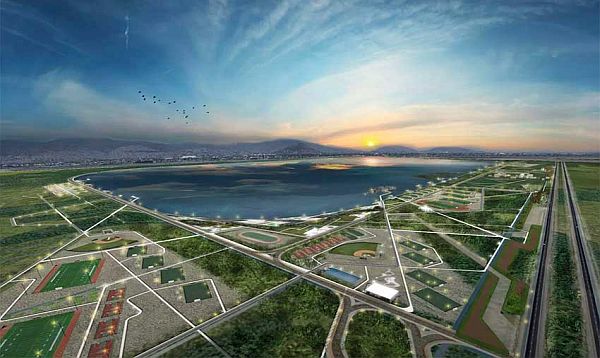MEXICO CITY – Mexico’s emblematic Texcoco ecosystem is a veritable ode to survival.
Whereas concrete was being poured over vegetation just a few months ago for construction of a huge new airport outside Mexico City, the cancelation of that project has changed the destiny of a site now slated to become a gigantic ecological park.
The decision by then-President-elect Andres Manuel Lopez Obrador to scrap the partly built $13 billion New International Airport of Mexico City (NAICM) was a controversial move and one that triggered the launch of a project aimed, among other things, at boosting the social development of the most deprived areas of the Valley of Mexico.
In an interview with EFE, the project’s architect, Iñaki Echeverria, said he was enthusiastic about the task the leftist head of state had given him.
“He spoke to me about beauty, and it’s unheard of for a politician to talk about that,” he said of a project that is to be completed in 2024 but may open to the public much sooner while still in the development stage.
The challenge of restoring this space is daunting. The site stretches for 16 kilometers (10 miles) north to south and covers an area of 12,300 hectares (47.5 square miles), two times the size of the island of Manhattan in New York City or nearly equivalent to 2,000 soccer stadiums the size of Mexico City’s Estadio Azteca.
“It’s a project that purports to achieve a better balance between the urban, the agricultural and the rural, and seeks to fulfill the goals of the National Development Plan and the 2030 Agenda (for Sustainable Development),” Echeverria said.
The park project will mean a tripling of the proportion of green areas per inhabitant in the Metropolitan Area of the Valley of Mexico, which has an estimated population of more than 20 million.
That proportion will rise from three square meters per inhabitant to nine.
The virtually peerless site dwarfs the Chapultepec Forest, an urban park in Mexico City that is one of the largest of its kind in the Western Hemisphere yet 20 times smaller than the Texcoco eco-park.
Due to the vastness of this space, formerly a lake that surrounded the Aztec island city of Tenochtitlan, it has had to be divided into four separate juridical areas.
A series of actions will be carried out at that immense site that steer it toward a more sustainable future, the architect said.
“We’re going to work with productive landscapes. We’re going to recover a spirulina (cynobacteria used in the production of food concentrates) farm that once existed. We’re going to work on local agriculture … and do certain specific reforestation work,” Echeverria said.
A series of solar panels also will be installed to harvest clean energy.
But some obstacles will need to be overcome, such as “the site’s accessibility and certainly the pre-existing works in the area,” Echeverria said.
One section of the Texcoco site still contains the remains of the NAICM project, which Lopez Obrador canceled after voters rejected it in an informal referendum organized by his party in October 2018.
Instead, Lopez Obrador, who took office a few weeks later, has opted for an alternate plan that involves expanding a military air base and connecting it with the current Mexico City airport.
The leftover construction material includes a total of 35 million cubic meters (1.2 billion cubic feet) of rocks and stones, part of which is to be reused for the park project.
The site where the park will be located is a zone of “great deprivation,” Echeverria said, adding that talks have already been held with local residents to ensure they reap the benefits of this project in terms of greater “work and education.”
He said the park “is a way of starting a conversation about the eastern portion of the Valley of Mexico” and could serve as part of a political and social agenda of great significance for that zone and the entire country.
“If this goes well, everyone will start making parks,” Echeverria said.
Lastly, the shift to a park project marks a victory for Mexican environmentalists, who had warned that construction of the new airport would destroy a fragile ecosystem.
Biologist Patricia Escalante told EFE that the Texcoco area is home to between 70,000 and 350,000 aquatic birds and also serves as habitat for large numbers of migratory birds.
Echeverria, for his part, said that the bulk of the ecological park would be a natural reserve and that flora and fauna will be the biggest beneficiaries.
Source: http://www.laht.com

